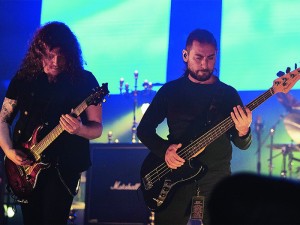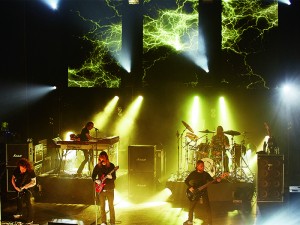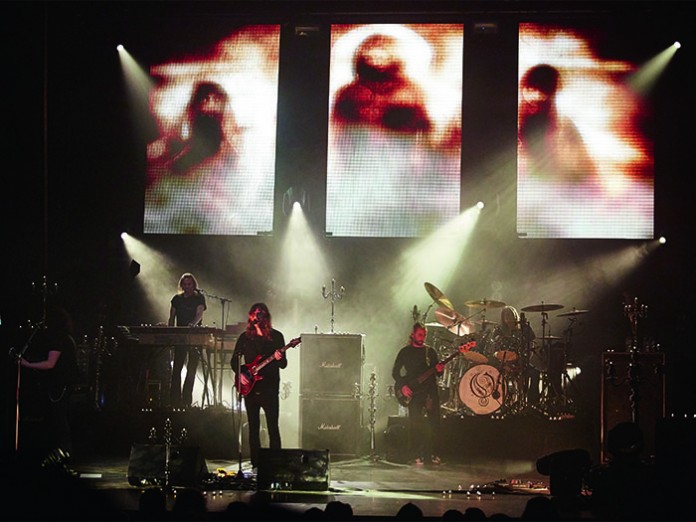To commemorate 25 years of performing as Opeth and 10 years since the release of the monumental Ghost Reveries album, the Swedish metal band set out to play a handful of exclusive shows across Europe and the US. TPi’s Ste Durham ventured to the band’s only UK date to discover the design behind Opeth’s brand new production.
Known for their trailblazing blend of metal, folk, prog, blues and jazz, Opeth have rarely strayed from underground music’s forefront since their death metal beginnings in 1990.
While their rise can hardly be called meteoric, perhaps thanks to the band’s propensity for 10-miunte plus compositions and unexpected stylistic shifts, they have grown into one of the most respected bands within their genre. When the time came to celebrate 25 years, a characteristically ambitious run of shows were announced to the baying masses of the Opeth faithful.
Although the sole UK date on Opeth’s anniversary tour was originally meant to take place at the London Palladium, an 11th hour change of plans saw the band proudly announce that they would become “the heaviest band to play the Theatre Royal, Drury Lane in all of its 350-year history”.
In order to appropriately celebrate their quarter century, the band opted to shoulder the full weight of the night’s entertainment themselves – kicking off the evening with a full playthrough of their critically-acclaimed 2005 opus, Ghost Reveries, followed by a second set of classics from their eclectic back catalogue.
Coming off the back of a busy festival season, the band’s feet had barely touched the ground long enough to rehearse what was perhaps the most complex production of their career – and some of the crew had no time whatsoever. Opeth’s Tour Manager, Steve Page, explained: “The night before the first show in Stockholm we had five hours to build the gig and, aside from a little pre-production, that was all we had to go on. The band was still a little bit nervous – it’s a hometown show so they had all their friends and family there – but it all went really well. It looks and sounds great now so we’re happy.”
Page has been full time with Opeth since 2009, and was full of praise for the “very low-maintenance” band. He continued: “They don’t complain much and are, first and foremost, a fantastic band to watch as musicians. This helps as I have to do three or four jobs!”
Page serves as Tour Manager, Production Manager, and Accountant, also orchestrating the VIP ‘meet and greet’ sessions for the band. He said: “I’m not stretched very often as it is quite a small production. There’s eight crew including myself and five band members – all in one bus and one truck. I’ve been doing this for a long time so its probably easier than it sounds!”
Acting as Production Manager, Page liaised with Lighting Designer and creative driving-force, Mick Thornton, to formulate a concept for Opeth’s celebratory theatre run. Page explained: “The band focuses on getting the set together and getting the songs right, allowing Mick and I to focus on the production side. It’s not a very complicated concept, but what Mick has created is very artistic and looks great. Rather than being a budget production, I would say it is a very sensibly thought-out tour from a financial point of view. It means we can have a great show, please the audience and have a bit of profit at the end as well.”
THE GRAND CONJURATION
The concept Thornton suggested was basing the lighting and video for every song around each of the corresponding albums’ artwork. He explained: “For the Ghost Reveries set, we decided to dress the stage with candelabras and tea lights, reminiscent of the album artwork. These are on stage from the beginning to create the walk-in look for the audience, then basically every song from that album is lit in sepia and CTO.
“I wanted the show to be as ‘Opeth’ as possible, and that meant the Ghost Reveries set had to be very disturbing, dark and eerie – to tie in with the themes of that album. Hopefully this style of lighting is going to be something no one has seen before in an Opeth show.”
All of the stage dressing is removed during the 20-minute intermission, which then allowed Thornton to introduce full colour during the second half. For this set, he employed strict colour palettes for each track, again to make a visual link between the song and the album it comes from.
Thornton added: “Although we didn’t have a chance to rehearse the show we have taken out on tour, I pre-programmed as much as possible. The change of venue hasn’t altered my plans too much as the Palladium and Theatre Royal, Drury Lane are quite similar, old-style theatre venues.”
This meant that Thornton and Lighting Crew Chief / Video Operator Paddy Sollitt had to build the rig quickly each night, in order to get as much groundwork done as possible. Luckily, this tour was not Thornton’s first outing with the Swedish five-piece. He said: “I know Opeth and the songs themselves very well and it was just a case of working out the little nuances during the first few shows. I have worked as the band’s LD on and off, and even tour managed them for a while.”
One thing that shines through with Thornton, in addition to his familiarity with band, is his genuine appreciation of the musical, dynamic and thematic complexity that Opeth has honed over decades at the cutting edge. “They are a dream to light, given the sudden dynamic shifts, and it helps that I’m a big fan of the music as well. It is still challenging to programme these kinds of songs though, as they can change from being really in your face to almost silent in an instant. This has to go for the lighting as well. I can be bumping everything I’ve got one minute then snapping straight to just one spotlight on frontman Mikael Åkerfeldt the next, leaving the rest of the band in complete darkness.”
The main focal point of the lighting / video rig, all of which was provided by Zig Zag Lighting, was the 30ft by 12ft DMT Pixel Mesh 12mm video wall. This was split into three sections of 800mm by 400mm panels, five wide by four deep, which loomed behind the band for the duration of the show. Four vertical lighting towers separated these panels, each topped with two Robe Robin 100 LED Washes flanking a Robin 600E Spot, along with a two-cell molefay further down the tower.
The two LED Wash and one 600E Spot combination was also rigged at either end of the truss above, along with more molefays and Martin Professional Atomic strobes, and at each end of the stage for floor-level lighting. Thornton controlled this understated rig with an Avolites Pearl Expert with Titan software.
He stated: “I was happy with the Robe fixtures that we chose. I would have ideally liked BMFLs, but the rig had to be minimal. I was allocated half a truck for all of the lights and video, so I had to design accordingly. The Avolites Pearl Expert is a no brainer on this tour because of the venues we are playing, the time we’ve got and my style of lighting. It allows me to be as hands-on and creative as possible.”
Prior to setting out on the road, Thornton visited Zig Zag’s Leeds office in order to use the Capture lighting design software. This included choosing all of his palettes for the show and storing them within the console.

FAITH IN OTHERS
Although the band has never toured with such a degree of video before, it was an aspect that the team were keen to incorporate into the anniversary shows. To accentuate the song-specific lighting, Thornton also produced bespoke video content to accompany each track in the set. He created the imagery in consultation with Graphic Artist and long-time Opeth collaborator, Travis Smith.
Thornton said: “I have been lighting for over 30 years but was an art student in a previous life. The content creation is a bit of an outlet for me in that way. As with many productions these days, we are working to a tight budget, but I think we really came up with some exceptional looks. We try to develop the feel of each song and make it so that the video content is pretty disturbing as well.
“I live in a village in Yorkshire called Saltaire, which has a great deal of historically-interesting sites. There’s also some great woodland nearby so I went out and started filming. Some of the content you see on the video walls is filmed at these locations, along with manipulated versions of some of Travis’ Opeth album artwork,” he continued.
The video rig for the tour takes 20 minutes to float under the guidance of either Thornton or Sollitt and two local crew. Sollitt was added to the crew for the anniversary tour to keep on top of the video content during the show, allowing Thornton to position himself and his Avolites desk out in the auditorium. Video control was provided by the now discontinued Maxedia from Martin Professional.
Sollitt explained that, while the Maxedia was challenging to use, it also allowed the scope for creativity that the show required. He commented: “When it comes to using the Maxedia, knowing the songs really helps. It’s an older piece of kit but it lets you be much more artistic. We are trying to keep it quite abstract but still in line with the album artwork.”
All of the content for the video screens was created at the beginning of 2015 and, even then, the intention was to keep the first set as a single entity from a visual point of view.
Sollitt continued: “There’s a suggestion of colour in some of the video content during the first set, but Mick wanted to stick quite closely to the theme of sepia and white light. This is really effective when we come out for the second set and the colour just hits you in the face.”
As well as emphasising the sense of occasion, the addition of video also provided an alternative way of adding visual flair to accompany the band’s focussed musicianship. Page added: “Opeth are a very special band to watch but the guys themselves do not move very much. Even in the past Mick and I have made sure that there was always a lot of lighting action going on above and around them. With the video, we wanted to spend a bit more time and effort to give something extra for the fans. We think it’s worth it for this tour.”
HERITAGE
Opeth have made a habit of using in-house PA systems and this has not changed during their anniversary tour. For consistency’s sake, the crew rented a Yamaha M7CL-48 monitor desk from another long-time associate, STS Touring, along with a custom built set of two 48-way VDM Connectors. As a result, Page claimed that the rig is that simple, “it almost runs itself.”
FOH Sound Engineer Olle Sandqvist explained: “Basically all I’m carrying on this tour is a microphone pack. To be honest I don’t mind using house consoles, especially with theatre venues like this because there’s no real place to put it. Nowadays with digital desks it’s so easy to load up your file so that you have a place to start.”
While taking charge of two consecutive sets is quite a challenge, Sandqvist did have chance to catch his breath during the intermission. This also allowed him to tweak the mix in order to cater for the slightly heavier first set, and prepare for the varying dynamics throughout the second.
He continued: “The band wants to sound organic so I try to do as little processing as possible in terms of compression, gates and so on. For example, Martin “Axe” Axenrot the drummer is very dynamic, and quickly changes from a heavy beat to a softer, jazzy part – this makes it almost impossible to gate him. I’d rather ride the faders during a song to keep the dynamics in tact.”
Although it was his first time on the road with Opeth, Monitor Engineer Stefano Cassese was quick to acclimatise to the preferences of each band member. This meant keeping on top of the in-ear levels and making sure the mix retained its vitality. He said: “I basically give a full mix to everyone plus their own instrument on top. Mikael, for instance, has a full mix, then I add some low end and mid range from the side fills just to give him more punch. The in-ears are great for clarity but you need more life in the mix as well.”
Much like the rest of the crew, Cassese maintained that life gets easier the more familiar the setlist becomes. He added: “After 12 shows the mix has improved for everyone, so I’m really pleased.”

ENDING CREDITS
Hampshire-based trucking company Stagetruck was tasked with transporting the gear for the European leg of the tour. Although only one truck of kit was to accompany the Beat The Street tour bus around the continent, the route had potential to become extremely challenging as the tour progressed.
Stagetruck’s Will Johns commented: “Originally it was only going to be a 30ft trailer but, because it is the 25th Anniversary tour, they increased to a 45ft Mega Cube as the lighting rig got bigger. This is pulled with a Scania Euro 5 unit. While there is just one driver, we do use extra drivers for some overdrives on the tour.”
“We have done many tours with Opeth and also have a long history with their LD Mick Thornton, back to the Paradise Lost and New Model Army days.”
According to Johns, while most of the tour remained “pretty straightforward” from his point of view, the biggest potential problem was the overnight drive from Paris to London. With the ongoing Syrian refugee crisis causing transport disruptions at Calais for ferries as well as the Eurotunnel, Page and the team had to make contingency plans involving a duplicate rig that would be rented from the UK. Luckily these were not needed, and the crew arrived with time to spare.
Once in London, Johns said that the job returned to being routine. He commented: “While it’s not the easiest venue, the Theatre Royal, Drury Lane is only one of a lot of challenging places we visit, so it didn’t pose much of a problem. Although trucking an anniversary tour is no different for us logistically, it is always nice to be involved when bands hit landmarks in the career.”
The final piece in the logistics puzzle was the bussing provided by industry stalwarts Beat The Street. Page explained that he and the team chose the company it has “great buses, is very easy to deal with and offers the best tour support you can ask for.”
He continued: “From the tour accounting perspective it’s great, as all the on-the-road costs are inclusive with the rental price so I’m not dealing with cash payments to drivers. The band have always said that the bus is our home so we should always go for the most comfortable option available. On this run we had a very comfortable bus with a great driver, something you always get from Beat the Street.”
With this milestone now passed and the band’s quarter century all but celebrated, the crew could rest assured that the ambitious run of theatre shows was a resounding success.
Page concluded: “We have had a steady crew for the last few years, though we’ve added Paddy for this tour, so it all just seems normal now. The crew takes things as they come. It’s a change for us doing seated venues but other than that is just the same family feeling on tour, and it’s gone better than we could have hoped.”
TPi
Photos: Marie Korner
See the full Issue, on pages 60 to 67 in our November 2015 issue, available here: http://issuu.com/mondiale/docs/tpinov15_digitallr/1?e=7529423/31177621






